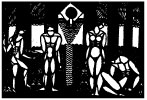| |
Thirst was the title play from a self-published volume by plays by Eugene O’Neill, written in the fall of 1913 while he lived in New London, CT, just months after he’d been released from a sanatorium for the treatment of tuberculosis. Thirst waswritten at the same time as O’Neill wrote two other plays dealing with shipwrecks, at least partially inspired by the sinking of the Titanic in 1912. This tragedy had been prolonged in the country’s consciousness by the public hearings that interviewed survivors for many months afterward. The play opens with three survivors in a life raft of a ship that has gone down, blistered from the sun after many days adrift, out of water to drink, and surrounded by sharks with no rescue in sight. The three characters are “A Gentleman,” still in his formal evening clothes though tattered by the wreck; “A Dancer,” dressed in a short-skirted costume of “black velvet covered with spangles”; and a West Indian mulatto crew member from the ship, who opens the play by singing “a monotonous negro song to himself as his round eyes follow the shark fins in their everlasting circles,” mixed with the Dancer’s sobbing.(1) The bulk of the play consists of conversation between The Gentleman and Dancer. Some of the conversation is about the Sailor, whose only lines until the end are “I have no water” and “I do not know.” There is exposition describing the shipwreck and how they came to be on the raft; the Gentleman tells how he was on the cruise for his first vacation after twenty years of “incessant grind,”(2) and the Dancer reveals she was “coming home . . . after years of struggling, home to success and fame and money.”(3) The Gentleman and Dancer both believe the Sailor is hiding water, which he denies, but in desperation the Dancer offers first a diamond necklace and then herself, both of which the Sailor rejects. In a fit of mad delusion, she imagines she is performing on stage and waves at the older Duke whom she believes will marry her, eventually dancing uncontrollably, ripping the bodice of her dress because of the heat, falling back to die. The Sailor brings out his knife, now singing a “happy negro melody that mocks the great silence,” and grins as he says “We shall eat. We shall drink.”(4) The Gentleman in disgust pushes the Dancer’s body into the water, causing the Sailor in rage to stab The Gentlemen, but The Gentlemen pulls the Sailor with him as he falls back and they both go overboard. O’Neill’s stage directions instruct that “The Sailor’s black head appears for a moment, his features distorted with terror, his lips torn with a howl of despair. Then he is drawn under.” The play ends in the “vast silence,” the sun glaring down “like a great angry eye of God,” and “on the raft a diamond necklace lies glittering in the blazing sunshine.”(5)
While clearly the work of a young writer, critics see in Thirst the “first flirtation with expressionism” and the influence of Strindberg and Maeterlink, who wrote “realistic plays with expressionist and symbolic elements.”(6) Though highly melodramatic, it nonetheless implies a “metaphor for the human condition,” playing out “a miserable existence with a certain end,”(7) representing “three of the world’s estates,” but, ultimately, “no general meaning finally evolves.”(8) The play pushes the envelope of subject matter for the time with its implication of interracial relationship and cannibalism, and for the stage direction of the Dancer to expose her breasts when she rips open her dress. The cast was George Cram Cook as The Gentleman, O’Neill as the Sailor, and Louise Bryant as the Dancer; Mabel Dodge reported in a letter that a drunk Cook said Bryant would be willing to expose her breasts in the play if needed.(9) O’Neill took on the most stage time of his entire career by performing in this play, supposedly encouraged by Bryant, with whom he was having an affair while she was the lover of John Reed. The set initially designed by William Zorach, with “a backdrop of formalized waves,” was rejected by O’Neill; Cook and Reed had to step in and tell Zorach that O’Neill was a “realistic playwright.” The backdrop was replaced by a painted “crumpled canvas,”(10) with “someone wriggling around underneath it” similar to the scene in his father’s Monte Cristo where he escapes into the sea.(11) William Zorach described in an interview with Sarlos that the “blue-green canvas” was “pulled back and forth by crewmembers hid behind the wings.”(12) There are two extant photos of the production, and on the back of one, O’Neill has written “This is a good example of the amount of collaboration demanded by us of the imagination of our audience when we played in the Wharf Theatre” and follows that “the people in the first row could have easily put their feet on the raft.”(13) However, Kenton, strangely, describes that the setting involved the pushing of the stage out the backstage door of the theatre, the one that rolled open to expose the sea, and that “by some trick of lighting,” it seemed “the players [were] playing over the sea . . . literally floating in it on their perilous raft.”(14) Since Kenton did not see this play until the “Special Performances” of the play on September 1 and/or 2, perhaps there was an attempt to set the play more realistically for these extra performances. In Bryant’s unpublished memoirs, she writes that Thirst “wasn’t much of a success,” and the play was not produced again by the Players.(15)
© Jeff Kennedy 2007.
(1) O’Neill, Complete Plays 31.
(2) O’Neill, Complete Plays 42.
(3) O’Neill, Complete Plays 41.
(4) O’Neill, Complete Plays 51.
(5) O’Neill, Complete Plays 51.
(6) Gelb, Monte Cristo 399; Murphy, Provincetown2/49.
(7) Murphy, Provincetown, 2/51.
(11) Gelb, Monte Cristo 573; Bogard, Contour 30.
(12) Sarlos, Provincetown 54.
(13) Sarlos Papers, Photo of Thirst, Special Collections, UC Davis.
|
